
How to train and stay in good climbing shape while living on the road, whether you’re van-lifing it, dirtbagging it, or sailing across the ocean.
The post I Live in My Van And Train on the Go. Here’s How I (and Some Pros) Make It Work. appeared first on Climbing.
]]>
Back in my small condo in San Francisco, my “gym” often consisted of a set of dumbbells wedged between the bed and the wall, a hangboard mounted above the doorframe, and a daily mobility flow squeezed between furniture. Like many climbers during the pandemic, I learned to train without fancy setups.
That DIY ethos became essential when I left city life to live and climb on the road last fall. Staying in shape wasn’t just about vanity or chasing grades—it was a necessity. I needed to keep up with rehab from injuries that almost pushed me out of climbing. To avoid backsliding, I also wanted to preserve range of motion and maintain strength. As I traveled through new places, I would often lack the convenience of gyms, yoga studios, or even flat ground.
So I brought the gym with me.
I mounted TRX straps and a hangboard to the ceiling of my van. I squeezed in adjustable dumbbells that I could load or strip down. Luckily, my van aisle is just wide enough for a yoga mat—perfect for a pared-down Ashtanga standing sequence most mornings. While the setup was simple, it works. In fact, it forced me to get clearer on what I really needed.
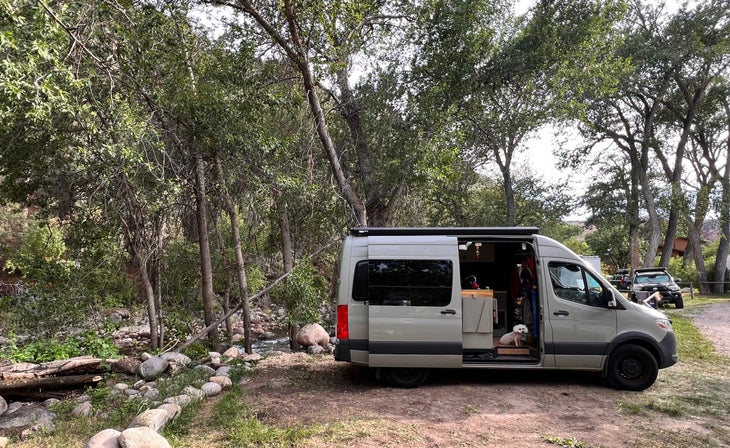
While on the road this past year, I’ve started noticing the creativity of other climbers living this life. Whether it’s swinging kettleballs at roadside pullouts or doing yoga by a desert campsite, the ingenuity of the portable gym mentality is endless.
In urban areas, climbers adapt in other ways. Once, at a Planet Fitness in Las Vegas (a city with world-class outdoor climbing, but meh climbing gyms), I saw two women improvising with a fingerboard they’d clipped to a squat rack—sneaking in fingerboarding between sets of sumo squats.
If you live and climb on the road—or aspire to one day—I’ve dug deep for the best climber van life training tips. I’ve drilled nomadic pros and I’m sharing my greatest discoveries to help you stay fit wherever you are. Best of all, you don’t need a fancy Sprinter van to take action on this advice. Whether you’re living in the back of your Subaru or sailing across the sea to a big wall objective, here are some ideas for training on the go.
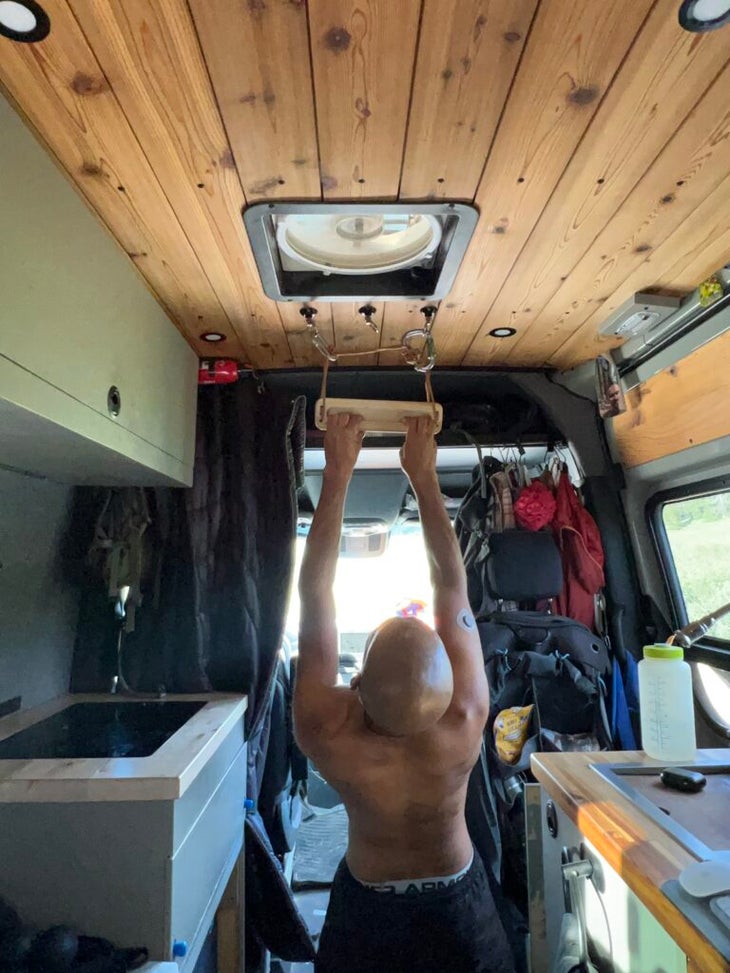
How pro climbers get creative with on-the-go training
I’ve interviewed several pro climbers who’ve managed to stay fit in wanderlust mode. Each example offers guidance for different on-the-go scenarios.
Roving (and sending) senior climbers
Chuck and Maggie Odette, in their 50s and 60s respectively, travel around the U.S. full-time in their van—and they’re still sending 5.13+. In an interview I with the Odettes last year for my podcast Ageless Athlete, Chuck described their itinerant setup in El Salto, Mexico:
“We’d be camped at the parking lot near the cliff and I’d warm up before heading to the wall. After climbing we’d do supplemental work—a crossfit-type of workout with pullups and pushups.”
They also carry BFR (blood flow restriction) bands that Maggie claims helps them recover better for actual climbing days.
This case study in climber fitness shows us that training doesn’t need to be high-volume. It just needs to be specific to objectives.
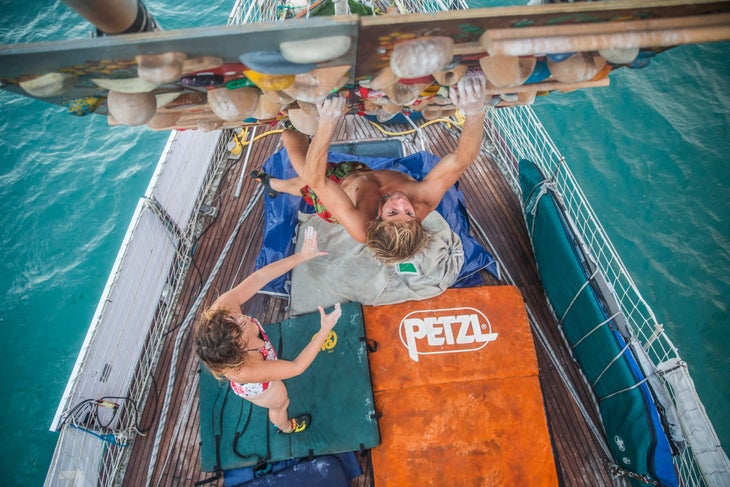
Staying in shape on the open sea
This January, Seb Berthe made the fourth repeat of the Dawn Wall. He spent a total of eight months on a sailboat traveling and training between Europe and Yosemite while projecting the route. Why a sailboat? To get to Yosemite from Europe with a minimal carbon footprint.
When I spoke with him on Ageless Athlete, Seb described how his training evolved over those multiple ocean crossings. On his first trip to attempt the Dawn Wall in 2022, he admitted that just standing up could be hard as he was often seasick. He brought a fingerboard but admitted that “trying to do max hangs on a moving boat was not ideal.”
So when Seb returned for his second attempt, he adapted. He and his crew installed a spray wall on the deck, and developed a creative new way to train:
“Depending on how the boat was tilting, I had different exercises. Sometimes it was really easy, and sometimes it was really hard. I couldn’t measure anything exactly, but I had to accept that. You can’t always know how strong you are when the floor is moving.”
That constant unpredictability—combined with a moving “mountain,” as he put it—wasn’t just a hindrance. It became a hidden asset. “It’s actually quite good for the joints and muscles,” he said with a laugh. “Maybe a moving hangboard is something people should try.”
Because sessions were short—usually just an hour in the morning, then another in the afternoon—he focused on quality over quantity: “I couldn’t do a five-hour session. So I went really intense. Pure strength and power. And that’s maybe what I needed most.”
In the end, Seb believes the whole experience may have helped him prepare for Yosemite’s most legendary climb in ways no spreadsheet—or stationary training setup—ever could. “It got me more psyched,” he explained. “It put me out of my usual routine. Maybe it helped … or maybe that’s foolish. But I like to believe it.”
It’s hard not to agree with him.
These examples—van lifers, urban creatives, and ocean-bound athletes—point to the same truth: It’s not about having the perfect gym. It’s about solving for what you can do wherever you are.

Tips for climbers training on the road
After living in my van for over a year while climbing and rehabbing, these are the habits and tools that have helped me stay strong, consistent, and injury-free—even without a traditional gym.
- Define your training goal. Are you rehabbing? Building power? Maintaining finger strength? Know your “why” so you can set specific goals to work toward—and develop the on-the-go training setup needed to achieve them.
- Make movement part of your morning. A simple yoga or mobility flow can set the tone for the day. I try to do mine first thing—sometimes right inside the van. I lucked out with just enough space for a yoga mat, but often I’ll unroll it outside at a campsite or even a quiet trailhead. The key is consistency, not perfection—just find a flat spot, breathe, and begin.
- Invest in multi-use tools. Resistance bands, a yoga mat, suspension straps, and adjustable dumbbells cover a lot. I keep mine in one storage bin I can pull out easily. In smaller vehicles, try a collapsible crate or under-bed bin, or stash them around your space. For a hangboard, I drilled hooks to my van ceiling. Alex Honnold had one mounted to his van doorframe. You can even hang one from a tree branch if nothing else is available! Get creative.
- Use your environment. Campsites, chain gyms, climbing gyms, or any rest stop can serve as venues for training. At a rest stop, I’m usually just trying to sneak in a quick session right after snacking and napping—some band work, scapular hangs off my pull-up bar, or yoga stretches. You’re not there to impress anyone—just to move, refuel, and keep going.
- Train around your climbing days. As climbing coach Steve Bechtel recommends, train either before or after your climbing session, or early the next day. Stack your stress, then rest fully—especially if you’re trying to send hard projects.
- Training in public? Don’t be shy. Honestly, nobody cares if you are stretching it out at a train station, a gas station, or the boarding gate at Dulles waiting for your delayed flight. And who knows? You may just inspire others to follow suit.
- Don’t forget recovery. A yoga mat (get the travel-friendly one) and foam rollers (get the mini) can go a long way. I carry a massage gun, too, but admittedly, I never use it. The lacrosse ball works well for some good old self-massage.
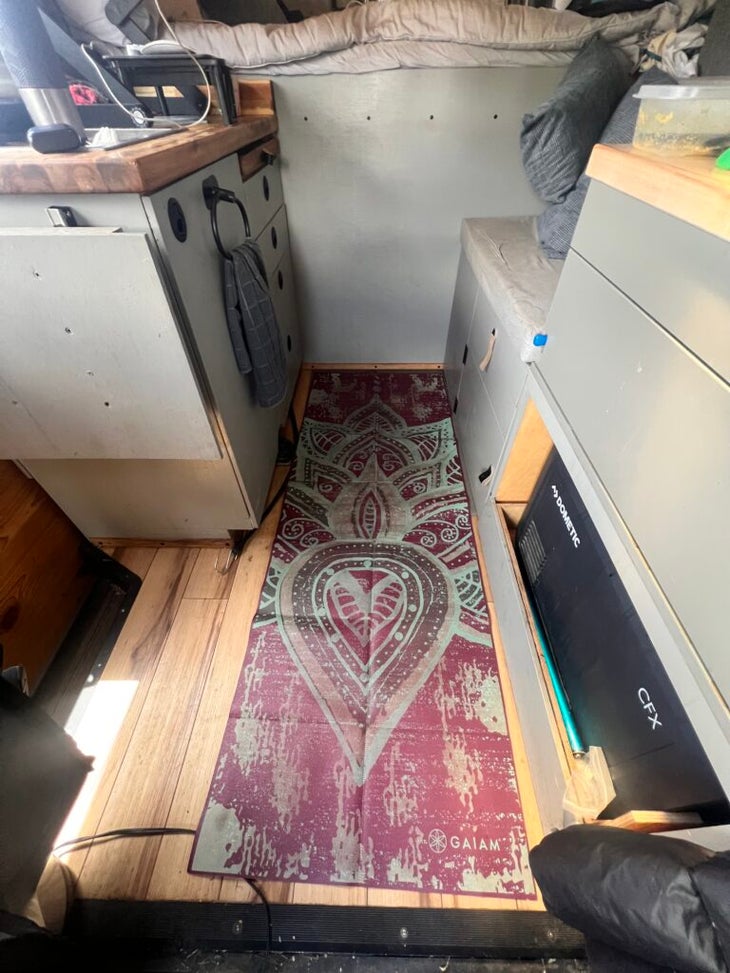
Let go of the script when it comes to training
One surprising gift of road life? I’ve stopped obsessing over structured training blocks.
For years, I thought progress required spreadsheets and periodized cycles. But living from a van—where rest days might depend on water availability or driving logistics—I’ve learned to improvise. I’ve discovered that sometimes, less is more.
Some days, it’s a 20-minute bodyweight session before breakfast. Other days, it’s a hangboard workout after climbing. Sometimes, it’s just stretching against my van while getting gas. And often, the most satisfying sessions are the ones I do outside—under the sun, by a river, or with the wind pushing through the trees. There’s something grounding about training to the rhythm of the day, not the clock.
There’s freedom in letting go.
As Seb Berthe told me:
“Being on the boat reminded me to enjoy the process. You’re not always in control, but you can always adapt. And adaptation is part of performance.”
Exactly.
Watch Kush give a tour of his van and various training setups
The post I Live in My Van And Train on the Go. Here’s How I (and Some Pros) Make It Work. appeared first on Climbing.
]]>
Crags and bouldering areas hidden in America's concrete jungle
The post 9 Cities With Surprisingly Good Climbing Less Than 45 Minutes Away appeared first on Climbing.
]]>
Think there’s no outdoor climbing near your city? Think again. Across the U.S., climbers in unexpected metro areas have carved out surprisingly solid places to send. Urban climbers scramble up graffiti-covered bridge abutments, link up post-work topropes, and preserve sandstone faces from development.
Of course, these aren’t world-class destinations—but they’re accessible, quirky, and worth checking out. These zones may be scrappy, but they’ve become cultural hubs, local proving grounds, and sometimes even launchpads for bigger goals. Here are nine U.S. cities where outdoor climbing exists surprisingly close to downtown—often within a quick Uber or bike ride.
 Washington, DC
Washington, DC
Crag: Carderock
- Distance from downtown: 12 miles / ~25 minutes
- Approach: Park at the north lot in Carderock Recreation Area, then follow the riverside trail west to the cliffs (~5-10 mins)
- Number of Routes: ~140 (mostly toprope, some trad and bouldering)
- Type of Climbing: Schist face climbing and technical bouldering
- Grade Range: 5.3-5.12, V2-V7
Why Carderock is cool: Carderock isn’t just D.C.’s local crag—it’s one of the most historically significant climbing areas on the East Coast. Nestled along the Potomac in the C&O Canal National Historical Park, the area’s clean gray schist and white quartz crystals have hosted generations of climbers, from mid-century pioneers to weekend gym escapees.
The cliff band rarely tops 40 feet, but the real challenge is in the footwork—delicate smears, micro edges, and high steps. Most routes are toproped using tree anchors, though a few lines go on gear. Bouldering also exists, tucked around Jungle Cliffs and Hades Heights. On weekdays, it can be a peaceful forest escape—until a jet flies overhead on approach to Reagan National Airport.
More info: Potomac Mountain Club
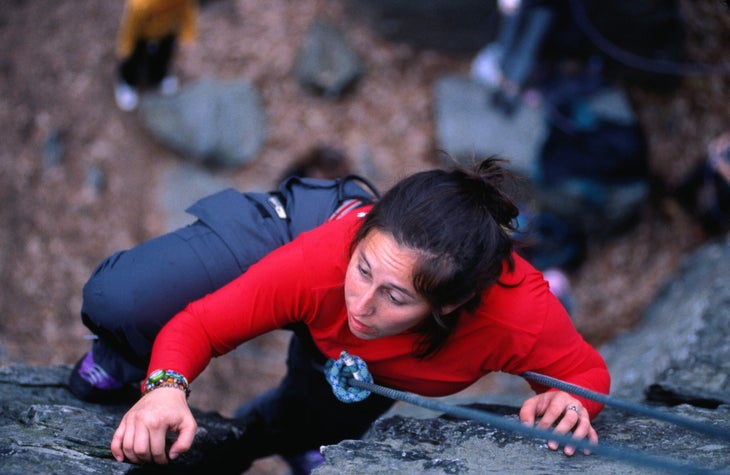
 Atlanta, GA
Atlanta, GA
Crag: Boat Rock & Chattahoochee River Corridor
- Distance from downtown: 12-25 miles / ~20-30 minutes
- Approach: Varies by area; most accessible via short hikes from public parks or trailheads
- Number of Routes: ~200+ boulder problems, 50+ toprope and trad routes
- Type of Climbing: Granite bouldering and short trad/toprope faces
- Grade Range: V2–V8+, 5.7–5.12
Why Boat Rock and Chattahoochee are cool: Granite slabs hide in Atlanta’s wooded pockets, from the preserved boulders at Boat Rock to the riverine corridors of Allenbrook and Island Ford. Boat Rock’s low, techy bouldering is famously unforgiving—demanding balance, footwork, and a tolerance for pad math. The climbing scene thrives on volunteerism and local advocacy, turning limited terrain into a deeply local culture built on effort and access.
More info: Southeastern Climbers Coalition – Boat Rock
 Charlotte, NC
Charlotte, NC
Crag: Crowders Mountain
- Distance from downtown: 30 miles / ~35 minutes
- Approach: 20-minute hike from Linwood Road access
- Number of Routes: ~175 roped routes and hillside bouldering
- Type of Climbing: Quartzite face climbing and bouldering
- Grade Range: 5.6-5.13; V0-V8
Why Crowders is cool: Crowders has been the first real rock experience for many climbers raised in the Southeast. Steep, sun-baked quartzite routes demand technical movement, and basic anchor knowledge often enables a top rope setup when leading is not an option. A grassroots bouldering scene is also emerging among hillside blocks. Consistent local stewardship keeps the area accessible and evolving.
More info: Carolina Climbing Coalition – Crowders Mountain
 Cleveland, OH
Cleveland, OH
Crag: Whipp’s Ledges
- Distance from downtown: 25 miles / ~35 minutes
- Approach: 5-10 minute walk from Hinckley Reservation parking lots in Cleveland Metroparks
- Number of Routes: ~100 toprope and trad routes, ~60 boulder problems
- Type of Climbing: Sharon Conglomerate sandstone—face climbing, horizontal breaks, and sloped crack systems
- Grade Range: 5.4-5.12; V0-V8
Why Whipp’s is cool: Whipp’s Ledges sits in the mossy ravines of Hinckley Reservation, offering short sandstone walls with horizontal breaks and slopey holds. The ethics here are traditional: long webbing, tree anchors, and minimal chalk. While modest in stature, the ledges offer plenty of challenge, particularly for those working on footwork and rope systems. For many Ohio climbers, this is where skills get sharpened before heading to the New or Red.
More info: Ohio Climbers Coalition
 Minneapolis, MN
Minneapolis, MN
Crag: Taylors Falls – Interstate State Park
- Distance from downtown: 39 miles / ~45 minutes
- Approach: Easy 5-10 minute walk from parking areas within the park
- Number of Routes: ~200 routes (85 toprope, 66 trad, 118 boulders)
- Type of Climbing: Basalt columns—think vertical cracks, blocky faces, and pocketed overhangs
- Grade Range: 5.4-5.12; V0-V11
Why Taylors Falls is cool: Taylors Falls feels more remote than it is. Stacked basalt columns rise above the St. Croix River in a setting that looks pulled from the Northwest. There’s no sport bolting here; Minnesota state parks encourage clean climbing ethics. Climbers sling trees, jam cracks, and set long toprope anchors in the piney shade. With nearly 370,000 visitors a year, it’s one of the most trafficked climbing areas in the Midwest—and a true proving ground..
More info: Minnesota Climbers Association
 St. Louis, MO
St. Louis, MO
Crag: Rockwoods Reservation Conservation Area
- Distance from downtown: 25 miles / ~30–35 minutes
- Approach: ~1/4 mile hike up a nature trail from West Christy Road
- Number of Routes: ~20 total (15 bolted sport, 4 boulders, 1 seasonal ice route)
- Type of Climbing: Short sandstone sport routes, featured boulders
- Grade Range: 5.7-5.12; V2-V6
Why Rockwoods is cool: Tucked into a quiet corner of Missouri oak forest, Rockwoods Reservation is the closest true outdoor climbing area to St. Louis—and it’s undergone a quiet renaissance. Originally a toprope zone, it’s now home to a growing selection of short, well-bolted sport lines, thanks to the efforts of BETA Fund and the Missouri Department of Conservation. Greensfelder Park lies just west of Rockwoods and offers hiking and mountain bike trails rather than roped climbing—but it adds a nice crossover option for multisport days.
More info: BETA Fund
 Chicago, IL
Chicago, IL
Crag: Henry C. Palmisano Nature Park (plus scattered buildering citywide)
- Distance from downtown: ~4.5 miles / ~15–20 minutes
- Approach: Park at 29th & Halsted; walk 2–3 minutes to the boulders
- Number of Routes: ~25 modern boulder problems at Palmisano; ~100+ buildering and DIY problems scattered citywide
- Type of Climbing: Artificial boulders, preserved dolomite quarry walls, and urban concrete features
- Grade Range: V2-V6+
Why Palmisano Park cool: Most Chicago climbers head for the Red when they can, but Palmisano Park offers a legit local option. Once a limestone quarry and landfill, it was transformed into a 26-acre climbing park through a partnership between The North Face and Trust for Public Land. The community provided input to help co-design the sculpted boulders, which sit just minutes from the Loop.
Scattered buildering at Montrose Beach, Steelworkers Park, and university slabs round out the scene. It’s not glamorous—but it’s grassroots, accessible, and entirely Chicago.
More info: Palmisano Project – Trust for Public Land
 Richmond, VA
Richmond, VA
Crag: Belle Isle and Greater Richmond Boulders (Buttermilks, Forest Hill, Manchester Wall)
- Distance from downtown: 0-5 miles / 5-20 minutes
- Approach: Varies—most areas are within walking distance or a short drive from city center
- Number of Routes: ~270 boulder problems and ~100 roped routes across multiple in-city parks
- Type of Climbing: Granite and quarried rock—slabs, faces, cracks, and traverses
- Grade Range: V0-V10; 5.6-5.12
Why Belle Isle and the Greater Richmond Boulders are cool: Richmond might be the most unexpectedly stacked city on this list. The James River Park System runs right through downtown, with granite boulders at Belle Isle, a bolted cliff band at Manchester Wall, and dense circuits in Forest Hill and the Richmond Buttermilks. Most locals treat the entire trail-linked network as their home gym, flowing between bouldering, paddling, and climbing—sometimes all in the same day.
Community stewardship is strong here, with trail days, meetups, and fresh chalk in every neighborhood. It’s an urban climbing ecosystem hiding in plain sight.
More info: James River Park Climbing
The post 9 Cities With Surprisingly Good Climbing Less Than 45 Minutes Away appeared first on Climbing.
]]>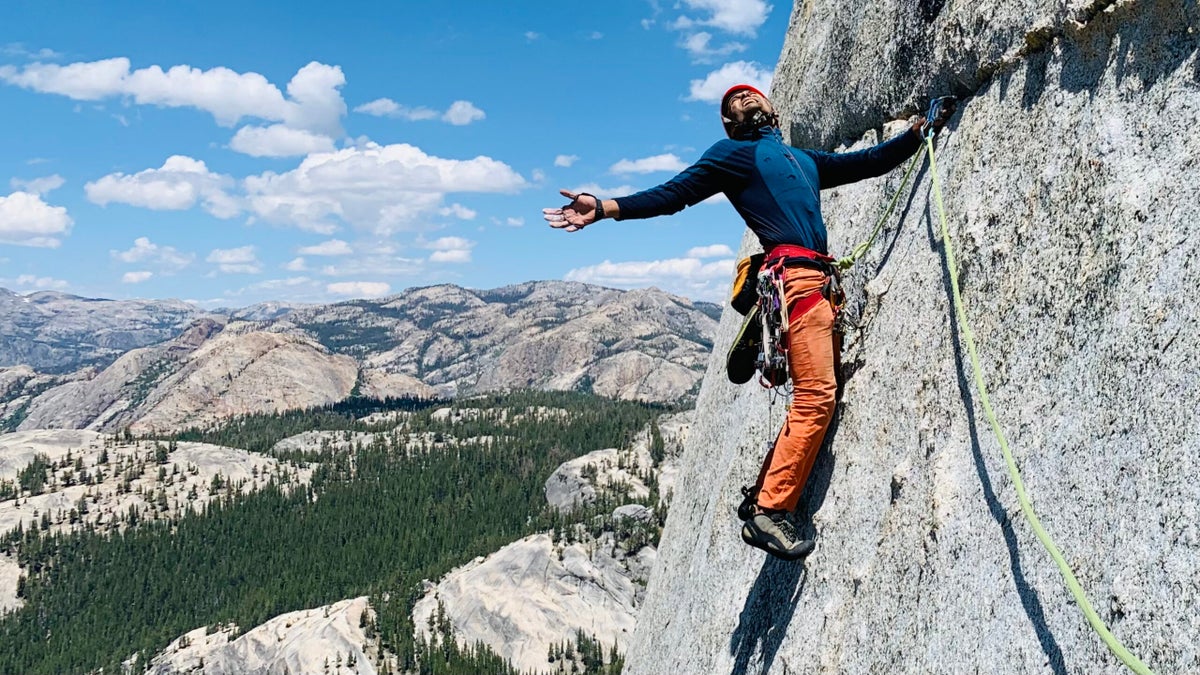
What I learned after injury, doubt, and dozens of conversations with elite climbers
The post Aging Isn’t Always Kind to Climbers. Here’s How to Stay Strong, Sharp, and Stoked. appeared first on Climbing.
]]>
In August 2023, I returned from three weeks of bouldering in the granite moonscape of Ladakh’s Suru Valley. It should’ve been a high point of the year—sharp alpine air, proud lines above wildflower meadows, trading beta over milky Himalayan chai. But when I landed back in Delhi, I couldn’t lift my left arm without wincing.
Among orthopedists, surgeons, and sports med specialists, the verdict was consistent: severe osteoarthritis combined with a frozen shoulder, colliding to shut down my movement.
“Avoid overhead sports,” one doctor said. Another floated the possibility of shoulder replacement. “You’ve had a good run,” someone told me. It felt like a eulogy.
I wasn’t ready to quit climbing. But I also wasn’t naive enough to ignore pain.
In the months that followed, I found myself searching for better answers—not just medically, but mentally and physically. That search eventually grew into Ageless Athlete, a weekly podcast I launched in January 2024, where I speak with outdoor athletes across disciplines: climbers, ultrarunners, surfers, mountain bikers, and more.
Each conversation has been a window into how to adapt, endure, and keep chasing what we love, even as the years stack up. While every athlete offered insights that I draw upon in this story, I’m focusing on advice from the climbers I’ve spoken with—legends and lifelong practitioners like Lynn Hill, Steve McClure, Thomas Huber, Ben Moon, Craig DeMartino, and Hans Florine.
Those conversations didn’t just inform my recovery. They redefined it.
Here are the strategies that shaped my journey back—lessons for any older climber who wants to keep moving, continue progressing, and find more joy on the wall. These are eight of the biggest lessons I carried forward.
Author Kush Khandelwal talks through his favorite three lessons from this story
1. Start by advocating for yourself
When I spoke with Craig DeMartino—the longtime adaptive climber in his upper 50s who has returned to big walls—he emphasized how crucial it was to push past standard medical advice and build his own path to recovery. That also held true for Heidi Wirtz, a climber and guide in her early 50s known for hard big wall ascents around the world. Wirtz shared with me how she was once told she needed a hip replaced, but by seeking second opinions and committing fully to physical therapy, she avoided surgery and got back to the mountains.
Hearing their stories made me realize I had to take the same responsibility for my own healing.
I consulted multiple physical therapists while researching modalities I’d never tried—scapular stabilization, PRP (plasma rich therapy), deep rotator cuff activation, breathwork. Some of it helped. Some didn’t. But through that exploration, I began reclaiming agency. And I realized something both surprising and reassuring: The best climbers don’t wait passively for recovery to happen. They fight for it.
2. Let awe lead
In one of my earliest episodes of Ageless Athlete, I spoke with Thomas Huber, the German alpinist now in his upper 50s, and half of the renowned Huber Brothers. He described standing below towering alpine walls, where fear meets reverence, and the mountain reminds you that smallness is its own kind of power. “It’s humbling,” he said, “but also energizing. The beauty fills your lungs.”
That idea changed how I approached not only my climbing, but my day-to-day life, too. Walking my dog up Bernal Hill by my home in San Francisco, or clipping chains on a coastal crag just past Golden Gate Bridge, I started pausing—not to perform, but to absorb.
As I get older, I’m learning that days like that—easy, joyful, rich with presence—aren’t lesser days. They’re the ones that keep me connected to climbing for the long haul.
3. Power isn’t just for the young
When I interviewed Lee Sheftel—who is still sending 5.12 in his late 70s—he told me something simple and profound: “Power is the first thing to go. So it should be the first thing you train.”
He didn’t start training power until his 50s. At a time when most climbers were scaling back, he was building up with system boards in his garage, and short circuits to keep the fast-twitch sharp.
Another guest, Ben Moon—a climbing pioneer who is still elite into his late 50s, and the inventor of the Moon Board—emphasized that staying sharp doesn’t always require high volume, but it does demand focus. “One good session a week can hold the line,” he told me.
Back in San Francisco, I took that to heart and committed to the Kilter Board. Early on, I flailed on V3s that kids breezed through. But over time, I climbed back into V5s, then V6s. Even if those were still warmups for the teenagers around me, I could feel the spark returning.
When I arrived at the steep, tufa-laced walls of El Salto this January, that work paid off. My first project: Ungabunga (12c), steep, resistant, with just enough commitment to keep me honest. It took effort, tension, and love of the process. When I surprised myself with a quick send, it wasn’t luck. It was everything I’d rebuilt through my power-focused training.
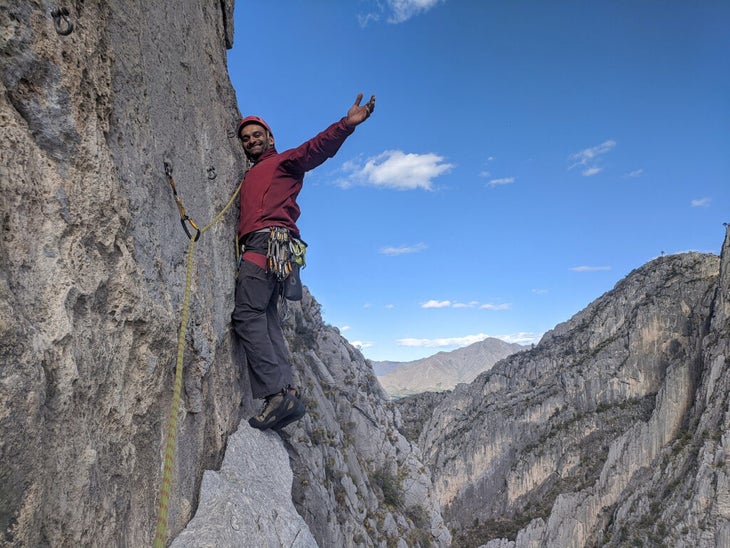
4. Fear isn’t the enemy. But it is loud.
My relationship with fear changed a dozen years back after a serious fall at Lover’s Leap in Tahoe. It was the result of a bad decision. I was climbing in a blizzard with no headlamp, a light rack, and dwindling daylight. We made it out, but the experience left a scar—one that deepened after losing three climbing friends in the years that followed.
When I interviewed Hazel Findlay, a British climber equally renowned for her hard lines and mental coaching, I admitted that I’d started avoiding big days in the alpine. Findlay didn’t downplay that. She reframed it. “Fear is information,” she said. “Exposure therapy helps you reframe it—bit by bit.”
That same winter that I was in El Salto, I also went to Potrero Chico—not for the bold trad routes, but for systems and exposure on long bolted lines like Black Cat Bone, 5.10d and Sendero Diablo 5.11c. As I moved higher with each pitch, I felt that fear slowly quiet. Not disappear, but shift. My mind stopped forecasting consequences. I was simply there, climbing.
5. Mentorship can give you back your fire
When I spoke with Craig DeMartino in the first season of my podcast, he shared how mentoring adaptive climbers after his accident gave him a renewed sense of purpose—something bigger than grades or accolades. “I wouldn’t wish the fall on anyone,” he said of the 100-foot ground fall he took over two decades ago, “but mentoring others gave me back something bigger than performance. It gave me peace.”
It made me think about how, as we get older in climbing, renewal doesn’t always come from pushing ourselves harder. Sometimes it comes from connecting with others.
This past season in Potrero Chico, I wasn’t the mentor. I was the one soaking up the energy of a younger crew—stoked, hungry, and wide-eyed. Watching them light up at their first multipitch adventures reminded me why I started. Their joy lit a spark in me that no solo training block ever could.
And maybe that’s what mentorship can look like, too. It’s not always about teaching, but sharing presence. Let energy flow in both directions. Let’s remind each other, across generations, what the sport is really about.
6. Recovery is performance
Eric Hörst, a climbing author and coach in his early 60s, told me, “You don’t get stronger from training. You get stronger from recovery.” Matt Samet—a climber, writer, and longtime Climbing contributor and former editor in his early 50s—echoed that, crediting his longevity to yoga, mobility, and listening more than pushing.
Since then, I’ve rebuilt my daily rhythm around that truth. Whether in San Francisco or my van, I carry what I need: a yoga mat, resistance bands, two adjustable dumbbells. I do my shoulder rehab in parking lots, activate with deep stretching in campgrounds, and never skip post-session care. My shoulder isn’t bulletproof, but it’s resilient. Because I’ve earned that trust again.
7. Movement before metrics
After injury, it’s easy to obsess over numbers—what you used to send, what you’ve “lost.” But in my conversation with Steve McClure, the British sport climbing icon in his mid-50s, he reminded me to chase feel, not figures. “If you’re tuned in to movement,” he said, “the numbers take care of themselves.”
These days, whether I’m hugging tufas in Guadalcázar, Mexico or warming up at the Happy Boulders in Bishop, I focus on movement quality. I climb to feel efficient. Calm. Curious. And more often than not, the grades seem to follow.
8. You don’t have to peak to progress
Lynn Hill—American climbing icon now in her early 60s—put it plainly when I interviewed her last summer: “I’m not chasing my old numbers. I’m chasing what’s possible now.”
That stayed with me.

Routes I once walked up now sometimes spit me off. And yet, as I move through the U.S. and Mexico — climbing, working, and piecing together a new sense of self — I find myself relishing the simple act of movement again.. As I link lines up to 5.12, I climb with flow and focus. Rather than fighting for numbers, I’m chasing connection.
It doesn’t mean I’ve given up on harder grades. Far from it. But for now, I’m loving where I am—still growing, still learning, and rekindling my love for the process.
Still sending
This journey back hasn’t been linear. Some days, my shoulder aches. Some nights, doubt creeps in. But I’ve learned to listen—not just to my body, but to the stories shared with me by those who’ve walked this path before.
At 47 years old, I’m not the climber I was at 30. But I’m something better: aware, engaged, still evolving.
If you’re rebuilding after injury, or wondering whether your best days are behind you, I hope my story—and the wisdom of the climbers I’ve spoken with—lands as a reminder:
Sometimes the best days aren’t about grades or numbers at all.
Last summer, I spent a quiet weekend at Donner Lake in Tahoe. I climbed easy routes, nothing close to my limit. But the granite, the lake breeze, and the scent of pine warmed by the sun, reminded me that presence not performance is what stays with you.
Getting older has taught me that it’s not always about pushing harder. Sometimes, it’s about staying close to what you love.
You’re not broken. You’re just in the middle of your story.
The post Aging Isn’t Always Kind to Climbers. Here’s How to Stay Strong, Sharp, and Stoked. appeared first on Climbing.
]]>